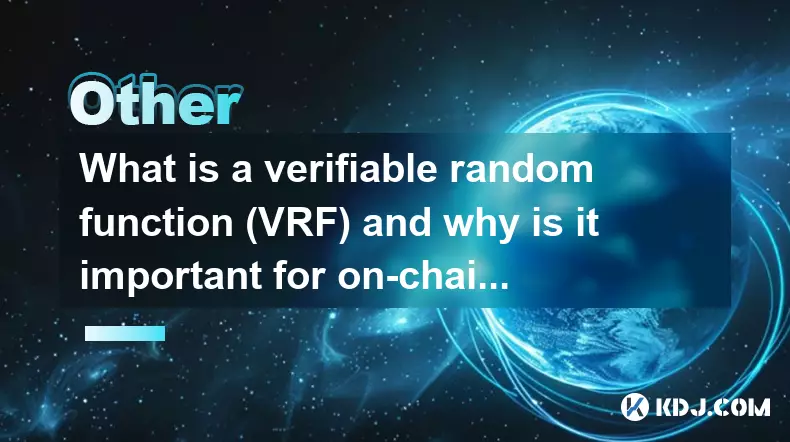-
 bitcoin
bitcoin $105968.894684 USD
4.17% -
 ethereum
ethereum $3639.320047 USD
7.62% -
 tether
tether $1.000339 USD
0.06% -
 xrp
xrp $2.407774 USD
5.96% -
 bnb
bnb $1011.704193 USD
2.28% -
 solana
solana $166.942754 USD
6.37% -
 usd-coin
usd-coin $1.000143 USD
0.03% -
 tron
tron $0.291515 USD
0.25% -
 dogecoin
dogecoin $0.181682 USD
4.06% -
 cardano
cardano $0.585450 USD
4.54% -
 hyperliquid
hyperliquid $42.099968 USD
5.20% -
 chainlink
chainlink $16.160745 USD
5.45% -
 zcash
zcash $645.269648 USD
12.96% -
 bitcoin-cash
bitcoin-cash $507.430338 USD
2.80% -
 stellar
stellar $0.290357 USD
3.69%
What is a verifiable random function (VRF) and why is it important for on-chain gaming?
VRFs provide provably fair, tamper-proof randomness for blockchains, enabling transparent loot drops, NFT mints, and on-chain game outcomes with verifiable integrity.
Nov 08, 2025 at 10:19 am

Understanding Verifiable Random Functions (VRF)
1. A verifiable random function (VRF) is a cryptographic primitive that generates a random output along with a proof that the result was computed correctly and fairly. Unlike standard random number generators, VRFs ensure transparency and resistance to manipulation by providing on-chain verification capabilities.
2. The function takes a secret key and an input value to produce two outputs: a pseudorandom value and a cryptographic proof. This proof allows any third party to verify that the output was generated using the correct key and input without revealing the key itself.
3. In blockchain environments, where trustless computation is essential, VRFs solve the problem of generating randomness that cannot be predicted or influenced by miners, validators, or smart contract developers.
4. The deterministic nature of blockchains makes true randomness difficult to achieve. Traditional methods such as block hashes or timestamps are vulnerable to manipulation. VRFs eliminate this risk by ensuring that only authorized parties can generate valid randomness, while anyone can validate its integrity.
5. Projects like Chainlink have implemented decentralized VRF services that integrate directly with smart contracts, enabling secure access to verified randomness for applications ranging from NFT minting to loot box distributions in games.
Role of VRF in On-Chain Gaming
1. On-chain gaming relies heavily on fairness and transparency, especially when outcomes affect ownership, rarity, or competitive advantage. Without a reliable source of randomness, players may suspect foul play or centralization of control.
2. VRF ensures that game events such as item drops, character traits, or match results are both unpredictable and provably fair. For example, when a player opens a digital loot box, the contents are determined by a VRF-generated number, and the attached proof confirms no tampering occurred.
3. Because all data and proofs reside on the blockchain, every participant can audit past events. This level of openness builds trust among users who know they are not being cheated by hidden algorithms or backend manipulation.
4. Smart contracts governing gameplay mechanics can automatically trigger actions based on VRF outputs. Once the randomness is delivered and verified, the contract executes rewards or penalties accordingly, removing human intervention from critical decisions.
5. Games built entirely on-chain, often referred to as 'on-chain games,' use VRF to maintain state consistency across nodes. Since every node must agree on game outcomes, having a universally verifiable randomness source prevents forks and disputes.
Security Advantages of Using VRF
1. One major threat in decentralized systems is front-running, where malicious actors observe pending transactions and exploit knowledge of upcoming events. VRF mitigates this by separating the request phase from the fulfillment phase, making it impossible to predict the outcome before it's revealed.
2. The cryptographic proof accompanying each VRF response prevents spoofing and replay attacks. Even if an attacker intercepts a previous result, they cannot reuse it because inputs are typically tied to specific transaction contexts or request IDs.
p>3. Decentralized oracle networks that deliver VRF responses operate under economic incentives and slashing conditions. Node operators must stake collateral, which they lose if they submit invalid or fraudulent randomness, further enhancing reliability.
4. Unlike off-chain RNG solutions, which require blind trust in external providers, VRF enables end-to-end verification within the same trust model as the blockchain itself. There is no need to rely on opaque third parties.
5. The immutability of blockchain records ensures that once a VRF result and its proof are stored, they become part of the permanent ledger. This permanence supports dispute resolution and long-term auditing for compliance or community scrutiny.
Frequently Asked Questions
How does VRF differ from traditional RNG in blockchain applications?
VRF differs fundamentally by producing not just a random number but also a verifiable proof. Traditional RNG methods like blockhashes lack this proof mechanism, making them susceptible to manipulation by miners or validators who can influence the final hash through selective transaction inclusion.
Can VRF be used outside of gaming in the crypto space?
Yes, VRF has broad utility beyond gaming. It is used in decentralized identity systems, lottery protocols, consensus leader election in some blockchains, and fair distribution mechanisms for NFT mints where order or allocation needs to be random yet transparent.
Is VRF completely immune to attacks?
No system is entirely attack-proof, but VRF significantly raises the bar. As long as the private key remains secure and the underlying cryptography holds, the function resists prediction and tampering. However, implementation flaws in smart contracts or oracle networks could still introduce vulnerabilities.
Do all blockchains support VRF natively?
Not all blockchains have native VRF support. Some, like Algorand, incorporate VRF directly into their consensus mechanism for leader selection. Others depend on external oracle services like Chainlink VRF to bring these capabilities to smart contracts.
Disclaimer:info@kdj.com
The information provided is not trading advice. kdj.com does not assume any responsibility for any investments made based on the information provided in this article. Cryptocurrencies are highly volatile and it is highly recommended that you invest with caution after thorough research!
If you believe that the content used on this website infringes your copyright, please contact us immediately (info@kdj.com) and we will delete it promptly.
- Altcoins, BlackRock, and a Bitcoin-Bullish Future: What's the Play?
- 2025-11-10 20:50:01
- Bitcoin Gains and Market Moves: What's Happening?
- 2025-11-10 20:35:01
- Pi Network, MNT, BlockDAG Presale: Decoding the Crypto Landscape
- 2025-11-10 21:25:01
- Bitcoin, Crypto Prices, and Dollar Strength: OG Wallets Stir the Pot
- 2025-11-10 21:10:02
- Pepeto Exchange Tackles the 'Tate Problem' and Sets the Stage for Crypto in 2026
- 2025-11-10 21:20:01
- Bitcoin ETF Outflows: Decoding the Weekly Trends and What They Mean
- 2025-11-10 21:20:01
Related knowledge

What are intents in crypto and how do they change user interaction?
Nov 09,2025 at 09:00am
Understanding the Role of Decentralized Exchanges in Modern Crypto Trading1. Decentralized exchanges, commonly known as DEXs, have reshaped how trader...

What is restaking and how does it enhance economic security?
Nov 09,2025 at 11:40pm
Understanding Restaking in the Blockchain Ecosystem1. Restaking refers to the process where users who have already staked their tokens in a proof-of-s...

What is a sovereign rollup and how does it differ from a smart contract rollup?
Nov 10,2025 at 09:00am
Understanding Sovereign Rollups1. A sovereign rollup operates as an independent blockchain layer that leverages the data availability of a base layer,...

What is a cryptographic nonce and how is it used to prevent replay attacks?
Nov 08,2025 at 05:00pm
Understanding Cryptographic Nonces in Blockchain Systems1. A cryptographic nonce is a number used only once within a specific cryptographic communicat...

What are the trade-offs between liveness and safety in a consensus protocol?
Nov 09,2025 at 12:20pm
Understanding the Role of Liquidity Pools in Decentralized Finance1. Liquidity pools are foundational components within decentralized exchanges (DEXs)...

What is a call data in an Ethereum transaction and how is it used?
Nov 09,2025 at 01:59am
Understanding Call Data in Ethereum Transactions1. Call data refers to the information sent along with a transaction on the Ethereum network that spec...

What are intents in crypto and how do they change user interaction?
Nov 09,2025 at 09:00am
Understanding the Role of Decentralized Exchanges in Modern Crypto Trading1. Decentralized exchanges, commonly known as DEXs, have reshaped how trader...

What is restaking and how does it enhance economic security?
Nov 09,2025 at 11:40pm
Understanding Restaking in the Blockchain Ecosystem1. Restaking refers to the process where users who have already staked their tokens in a proof-of-s...

What is a sovereign rollup and how does it differ from a smart contract rollup?
Nov 10,2025 at 09:00am
Understanding Sovereign Rollups1. A sovereign rollup operates as an independent blockchain layer that leverages the data availability of a base layer,...

What is a cryptographic nonce and how is it used to prevent replay attacks?
Nov 08,2025 at 05:00pm
Understanding Cryptographic Nonces in Blockchain Systems1. A cryptographic nonce is a number used only once within a specific cryptographic communicat...

What are the trade-offs between liveness and safety in a consensus protocol?
Nov 09,2025 at 12:20pm
Understanding the Role of Liquidity Pools in Decentralized Finance1. Liquidity pools are foundational components within decentralized exchanges (DEXs)...

What is a call data in an Ethereum transaction and how is it used?
Nov 09,2025 at 01:59am
Understanding Call Data in Ethereum Transactions1. Call data refers to the information sent along with a transaction on the Ethereum network that spec...
See all articles























![🔥 Long awaited! The ancestor of Pi coin is about to take off? PI friends, come in and take a look! [Daily Coin Selection | Bitcoin Trend | Money Making Opportunities] 🔥 Long awaited! The ancestor of Pi coin is about to take off? PI friends, come in and take a look! [Daily Coin Selection | Bitcoin Trend | Money Making Opportunities]](/uploads/2025/11/10/cryptocurrencies-news/videos/6911e42f9bad7_image_500_375.webp)


















































